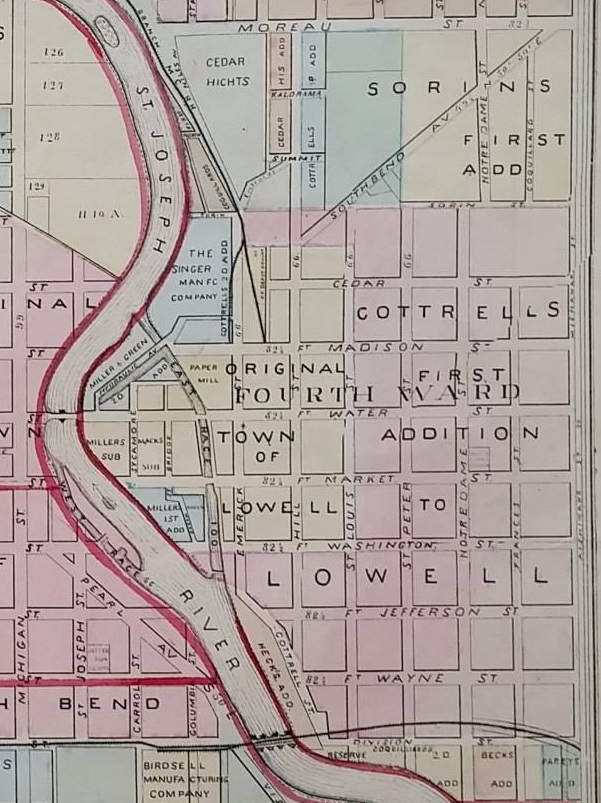
How did the East Bank Village begin?
We are lucky to live in the East Bank Village and are surrounded by reminders of its history…a history that helped form South Bend. Back in the day, water power was king and our proximity to the St. Joseph River put us in the heart of the industrial growth of the area. Platted in 1837 and named after the successful riverside manufacturing town of Lowell, MA, the narrow strip of land east of the river from Cedar Street to Jefferson and west to St. Louis Blvd. was recorded as the Town of Lowell. Additional parcels were laid out and registered by Samuel Cottrell. Although, Lowell was annexed by South Bend in 1866, “Lowell” and “Cottrell” still appears in our property descriptions on our tax bills and real estate documents.
So important was the industrial history of our area that in 1999 it was placed on the National Register of Historic Places as “East Bank Multiple Property Listing”. The application can be viewed at https://npgallery.nps.gov/GetAsset/bfdd7d8d-d9a9-4a74-9624-6ad1fb6c5056 and is a fascinating read. The dam and both races were completed by 1845; their water power first used by grist and saw mills. Singer Manufacturing Company was located here from 1868 to 1901 when it out grew its East Bank location and relocated. Several manufacturers occupied Singer’s East Bank location including South Bend Motor Car Works (fire vehicles) and South Bend Lathe. Other manufacturers in the area included A. C. Staley Manufacturing (woolen mill latter known as Stephenson Underwear Mills), a porcelain company and Indiana Paper Company, South Bend Woolen Company, Winkler Brothers Wagon and Carriage Works, South Bend Toy Manufacturing and Lauber & Weiss Galvanized Works (J.C. Lauber Company). It is no surprise that employees of these businesses wanted to live within walking distance of their jobs. Homes were built and neighborhoods sprung up along with grocery stores, churches, schools and services to meet their needs.
Many structures from our past no longer remain but some are still standing proud serving their original purpose or having gone through successful adaptive reuse. Where else can you stand in the middle of an intersection (Colfax and Hill) and see the Queen Anne home built by the son of early Irish settlers (Martin Hoban House), still owned and occupied by the family; a school built in 1925, still thriving (St. Joseph Catholic Grade School); a Queen Anne firehouse built in 1892, now a private residence (Firehouse #3); a retail merchant building built in 1904 and still housing retail merchants like CircaArts Gallery and Carpenter Gothic (Charles McCormick Building); an 1880 Victorian home now the home of a women’s boutique, Inspire Me! (the Dilly/Probst House); a woolen mill now converted to apartments (Stephenson Underwear Mills); and an electric power plant built in 1911 converted to The Commerce Center, an office building (Indiana and Michigan Electric Company)?
Only one place I know and that’s the East Bank Village!